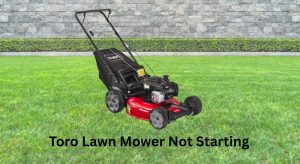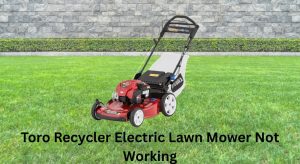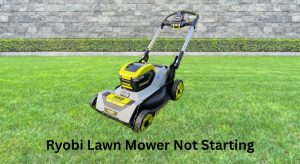Your lawn mower not turning over is frustrating—especially with grass getting taller by the day. The fastest quick fix? Check the safety switches and battery (for electric start), then ensure the spark plug wire is firmly connected. For pull-start models, inspect the pull cord engagement and make sure the blade/brake lever is fully engaged. Often, a loose connection, dead battery, or stuck safety interlock is all that’s stopping it.
In this complete guide, you’ll learn all the common causes of a lawn mower not turning over and step-by-step methods to fix it—whether you have a gas push mower, riding mower, or zero-turn. We’ll walk through battery testing, starter troubleshooting, fuel and ignition checks, and mechanical issues like seized engines or hydrolock. By the end, you’ll have your mower cranking confidently again.
Common Causes of a Lawn Mower Not Turning Over

- Dead or weak battery (electric start): Low voltage prevents the starter from engaging.
- Faulty safety switches: Seat, blade, brake/clutch, or PTO switches blocking the start circuit.
- Bad starter solenoid or relay: Clicking but no crank, or total silence.
- Corroded battery terminals or poor ground: High resistance limits current to the starter.
- Seized or stuck engine: Due to oil shortage, rust, or hydrolock (fuel/oil in cylinder).
- Faulty starter motor or stuck Bendix gear: Starter spins but doesn’t engage the flywheel.
- Blown fuse or faulty ignition switch: No power to the start circuit.
- Jammed blade/debris: Blade obstruction prevents rotation.
- Hydrostatic lock (hydrolock): Cylinder filled with fuel or oil, preventing piston movement.
- Faulty spark plug or ignition coil: Typically causes “turns over but won’t start,” but misdiagnosis happens.
- Old or bad fuel/gummed carb: Usually “cranks but doesn’t start,” but can cause hard cranking.
- Sheared flywheel key: Timing off; can feel like resistance during cranking.
How to Fix a Lawn Mower Not Turning Over

Follow the methods in order—from fastest to more advanced. Target time ranges are estimates.
Method 1: Quick Checks and Safety Interlocks (5–10 minutes)
Diagnosing the Issue
- Symptoms: No crank, single click, or silence when you turn the key/pull the cord feels locked. Safety interlocks are a common cause.
- Applies to: All mowers (push, riding, zero-turn); especially riding mowers with multiple safety switches.
Fix Steps
- Verify controls and safety switches:
– Ensure blade/PTO is OFF.
– Engage the parking brake/clutch as required by your model.
– Sit on the seat (riding mowers) and depress brake (some need both).
– For push mowers, hold the bail lever (blade control) fully against the handle. - Check the spark plug boot:
– Press it firmly onto the spark plug until seated. Loose boots prevent ignition and can interrupt kill circuits on some models. - Inspect the blade and deck:
– Disconnect the spark plug wire first for safety.
– Look for stuck branches, rope, or wire around the blade/shaft; remove obstructions. - Try to rotate the blade/flywheel by hand:
– With spark plug disconnected, tip the mower carefully (carburetor side up on walk-behind) and spin the blade by hand using gloves. If it’s seized or very stiff, skip to Method 4.
Testing
- Restore connections and try starting again. If still no crank, proceed.
Method 2: Battery, Cables, and Grounds (10–20 minutes)
Diagnosing the Issue
- Symptoms: Click but no crank, slow cranking, dim lights, or complete silence. Most common on riding mowers or push mowers with electric start.
Fix Steps
- Measure battery voltage:
– Use a multimeter. A healthy, fully charged 12V battery should read 12.6–12.8V at rest.
– 12.2V ≈ 50% charge; below 12.0V is discharged. - Load test (quick version):
– Turn key to start and watch voltage. If it drops below ~9.6V, the battery is weak. - Charge the battery:
– Use a smart charger at 2–10A until 12.6V+. Replace if it won’t hold charge. - Clean battery terminals and cables:
– Remove negative cable first, then positive.
– Clean posts with a wire brush; neutralize corrosion with baking soda/water.
– Reinstall positive first, then negative. Tighten firmly. - Inspect the ground connection:
– Trace the negative cable to the frame/engine block.
– Remove bolt, clean contact surfaces, and reinstall tightly. - Check inline fuse:
– Locate near the battery or ignition harness. Replace if blown (common sizes: 15–30A).
Testing
- Try starting. If still no crank or just clicking, continue to Method 3.
Method 3: Starter Solenoid, Relays, and Ignition Switch (15–30 minutes)
Diagnosing the Issue
- Symptoms: One or repeated clicks, no cranking; or absolutely nothing when you turn the key. Solenoid is a frequent failure point.
Fix Steps
- Locate the starter solenoid:
– Usually near the battery on riding mowers—small box with two large posts and two small control wires. - Listen and test:
– Turn key to start. If you hear a click, the solenoid coil energizes but contacts may be burned. - Jump the solenoid (diagnostic):
– Warning: Sparks possible. Wear eye protection.
– Use an insulated screwdriver to briefly bridge the two large terminals.
– If the engine cranks, the starter and battery are good; the solenoid or interlock circuit is bad.
– If no crank, suspect battery, cables, starter motor, or engine binding. - Check for 12V trigger at solenoid small terminal:
– With key in “start,” you should see 12V on the control wire.
– No 12V? Trace back to ignition switch or safety switches for interruption. - Test the ignition switch:
– Verify continuity on START circuit per wiring diagram. Replace if no continuity. - Replace the solenoid if it clicks but won’t pass current:
– Match the part number or use a compatible 12V mower solenoid.
Testing
- Attempt start. If starter spins but doesn’t engage the engine, move to Method 4. If silence persists, check safety switches continuity.
Method 4: Starter Motor, Bendix Gear, and Flywheel (20–40 minutes)
Diagnosing the Issue
- Symptoms: Starter whirs but engine doesn’t turn (Bendix not engaging), grinding noise, or nothing from starter even with good power.
Fix Steps
- Inspect the starter gear (Bendix):
– Remove shroud if needed. Look for broken/stripped plastic gear or stuck shaft. - Free a stuck Bendix:
– Clean the starter shaft with electrical contact cleaner.
– Lightly lube with dry silicone or graphite (avoid heavy grease—it attracts dirt). - Check flywheel ring gear:
– Inspect teeth for damage. Rotate the flywheel by hand to see full circumference.
– Damaged teeth in one spot? The starter may engage if you rotate the engine slightly past that area. - Bench-test the starter:
– Remove starter. Apply 12V directly: positive to terminal, negative to body. It should spin strongly.
– Weak or no spin? Replace or rebuild the starter. - Reinstall and torque fasteners:
– Ensure good ground path via mounting bolts.
Testing
- Try starting. If the engine still won’t budge or is very hard to turn by hand, go to Method 5.
Method 5: Engine Binding, Hydrolock, and Mechanical Checks (20–45 minutes)
Diagnosing the Issue
- Symptoms: Pull cord won’t move, engine won’t rotate by hand, or it stops abruptly. After tipping the mower or heavy flooding, hydrolock is common.
Fix Steps
- Check oil level and condition:
– Extremely high oil level can indicate fuel dilution, causing hydrolock. - Clear hydrolock (walk-behind or rider):
– Remove the spark plug.
– Place a rag over the plug hole.
– Pull the starter cord or bump the starter button in short bursts to expel fuel/oil from the cylinder.
– Drain and change oil if contaminated with fuel (smells like gasoline, looks thin).
– Reinstall a new spark plug. - Inspect air filter and carburetor:
– A soaked air filter indicates flooding. Replace paper filters; dry out foam filters and re-oil lightly.
– Stuck carburetor float/needle can continue dumping fuel into the cylinder—clean or rebuild the carb if recurring. - Check for seized engine:
– With plug out, try rotating the flywheel by hand. If it won’t move at all, internal seizure may have occurred from oil starvation. Professional service likely required. - Verify flywheel key:
– If the engine binds unpredictably or kicks back when starting, the flywheel key may be sheared. Remove the flywheel nut and inspect/replace key as needed.
Testing
- Reinstall components, reconnect spark plug, and attempt start. If it cranks now, proceed to Method 6 for reliability.
Method 6: Safety Switches and Wiring Continuity (15–30 minutes)
Diagnosing the Issue
- Symptoms: Intermittent no-crank, cranks only under certain positions, or nothing unless jiggled. Common on seat, brake/clutch, PTO, and neutral switches.
Fix Steps
- Locate switches:
– Seat switch under seat, brake/clutch pedal switch near linkage, PTO/blade switch on the dash or under deck, neutral switch on transmission lever. - Test continuity:
– Use a multimeter to confirm the switch opens/closes correctly when actuated. - Bypass for testing only:
– Temporarily jumper the switch to verify if it’s the fault. Important: Do not operate permanently with safety disabled. - Inspect connectors and harness:
– Look for corrosion, loose spades, broken wires near hinges and linkages. - Replace faulty switches:
– Match part numbers; many are affordable and plug-and-play.
Testing
- Confirm the mower cranks consistently with switches engaged correctly.
Method 7: Fuses, Relays, and Control Modules (10–25 minutes)
Diagnosing the Issue
- Symptoms: No power to starter circuit, lights inoperative, persistent silence.
Fix Steps
- Check main and accessory fuses:
– Replace any blown fuses with same rating. Investigate shorts if it blows again. - Inspect start relay (if separate from solenoid):
– Swap with a known-good identical relay (e.g., headlight relay) for testing if applicable. - Verify ignition module/ECM (on some newer models):
– Consult the service manual; check for diagnostic LEDs or codes. Replace only after ruling out simpler faults.
Testing
- Turn the key and verify a strong crank. If still no crank, re-evaluate battery, grounds, and starter.
How to Prevent Future Starting Issues
- Keep the battery charged: Use a smart maintainer in the off-season.
- Clean and tighten terminals each spring.
- Store fuel properly: Use fresh, ethanol-free fuel when possible; add stabilizer for storage.
- Service the carburetor and change oil annually.
- Avoid tipping the mower carb-side down to prevent hydrolock.
- Inspect safety switches and keep linkages free of debris.
- Replace the spark plug each season or every 100 hours.
Pro Tips
- Label connectors when removing shrouds to avoid miswiring on reassembly.
- When jump-starting a riding mower, connect negative to the frame, not the battery post, to reduce spark near the battery.
- Use dielectric grease on electrical connectors to fight corrosion.
- If you hear a single loud click, test voltage drop across the solenoid’s large posts while cranking—over 0.5V drop indicates burned contacts.
- A slow-turning engine with a fully charged battery can point to a partially seized engine or failing starter—don’t keep cranking; diagnose first.
- After clearing hydrolock, always change the oil—running diluted oil can ruin the engine.
- Keep the deck and blade area clean; a wrapped cord or wire can mimic a seized engine.
When to Call a Professional
- The engine won’t rotate by hand with the spark plug removed (possible internal seizure).
- Repeated fuse blows or signs of melted wiring (short circuit).
- Starter engages flywheel but grinds loudly or flywheel teeth are missing (flywheel replacement requires special tools).
- Persistent no-crank after you’ve verified battery, solenoid, switches, and starter.
- You suspect a sheared crankshaft, bent blade shaft, or governor damage after impact.
What to look for in a service provider:
– Factory-authorized for your brand (Briggs & Stratton, Kohler, Kawasaki, Honda).
– Upfront diagnostic fee and clear labor rates.
– Access to OEM parts and service manuals.
– Warranty on labor and parts (30–90 days typical).
Typical cost ranges:
– Battery: $35–$100
– Solenoid: $15–$40
– Starter motor: $80–$200
– Diagnostic + labor: $80–$200+
– Flywheel or internal engine repair: $200–$600+
Warranty considerations:
– Do not modify or bypass safety systems—can void warranty.
– Use OEM electrical parts where required.
FAQ
Q: What’s the difference between “not turning over” and “not starting”?
A: “Not turning over” means the engine won’t crank—no rotation of the engine. “Not starting” means it cranks but doesn’t run. This guide focuses on no-crank, but some steps overlap.
Q: Can I jump-start my riding mower with a car?
A: Yes, if both are 12V. Keep the car OFF to avoid voltage spikes. Connect positive to positive, negative to mower frame. Remove immediately after starting.
Q: My mower clicks but won’t start—what’s most likely?
A: Weak battery, corroded connections, or a bad solenoid. Start with battery voltage, clean terminals, and test the solenoid.
Q: Pull cord is stuck—what should I check first?
A: Disconnect the spark plug wire, then look for debris or cord wrapped around the blade. If the blade is clear and it’s still stuck, check for hydrolock by removing the spark plug and pulling to expel fluid.
Q: After tipping my mower, it won’t crank. Why?
A: It may be hydrolocked with oil or fuel. Remove the spark plug, clear the cylinder, clean/replace the air filter, and change oil if contaminated.
Q: My starter spins but doesn’t engage the engine. Fix?
A: Clean and lightly lube the starter/Bendix gear shaft, check for worn gear teeth, and inspect the flywheel ring gear. Replace worn parts.
Q: How often should I replace the battery?
A: Typically every 3–5 years, depending on use and storage. Keep it on a maintainer in winter to extend life.
Alternative Solutions
Sometimes the primary fixes don’t apply or the cost isn’t worth it. Consider these options:
| Solution | Pros | Cons | Best For |
|---|---|---|---|
| Replace battery and solenoid as a set | Quick restore of start circuit reliability | Slightly higher upfront cost | Older riders with intermittent no-crank |
| Install battery maintainer | Extends battery life, always ready | Needs outlet access | Seasonal storage |
| Convert to pull-start (if kit available) | Bypasses electric start issues | Physical effort; not for all models | Small engines, budget fix |
| Professional carb/service package | Restores overall reliability | Service cost, downtime | Mowers with multiple age-related issues |
Get Your Lawn Mower Working Again
By following this guide, you now have multiple ways to fix a lawn mower not turning over:
– Quick safety and obstruction checks
– Battery, cable, ground, and fuse diagnostics
– Solenoid, starter, and Bendix gear troubleshooting
– Engine binding and hydrolock remedies
– Safety switch and wiring continuity tests
Don’t let a no-crank mower derail your weekend. Work through the steps in order, and you’ll pinpoint the issue and get back to mowing fast. Still stuck with a lawn mower not turning over? Describe your model and symptoms in the comments for tailored advice. Found this helpful? Bookmark it for future reference—your mower will thank you.





